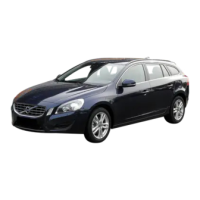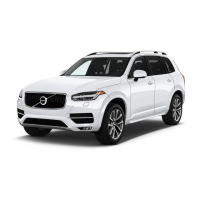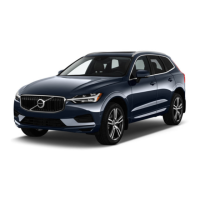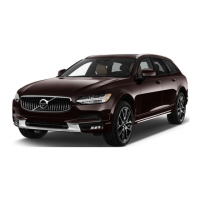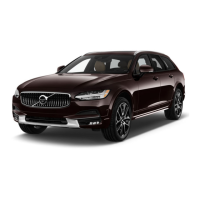
Do you have a question about the Volvo V90 TWIN ENGINE and is the answer not in the manual?
| Brand | Volvo |
|---|---|
| Model | V90 TWIN ENGINE |
| Category | Automobile |
| Language | English |
Information about your car is available in digital and printed formats, including a Quick Guide and supplement with specs and fuse info.
Access the owner's manual via the centre display for visual navigation and searchable content.
Download the Volvo Manual app for tutorials, visual navigation, and searchable content on smartphones and tablets.
Access owner's manuals, video tutorials, and further information on support.volvocars.com.
A supplement in glove box contains fuse and specification info, plus a Quick Guide for common functions.
Driver responsible for safe driving, following laws, and maintaining car per Volvo recommendations. Printed info takes precedence over centre display info.
A personal ID for accessing services like Volvo On Call app, Send to Car, and booking service/repair.
Volvo Car Corporation's commitment to developing safer, more efficient products with reduced environmental impact.
Volvo Cars' concept for car safety, comprising systems to protect passengers and road users.
Surf internet, use apps, and make car a Wi-Fi hotspot with intelligent interface and online connectivity.
Vehicle equipped with safety systems (airbags, tensioners, Whiplash Protection System) to protect occupants during accidents.
Guidance on correct seatbelt use and seating position adjustments for pregnant drivers.
WHIPS reduces whiplash injuries with energy-absorbing backrests, seat cushions, and head restraints.
PPS mitigates pedestrian impact in frontal collisions by raising bonnet rear section.
Importance of seatbelt usage for maximum protection, proper positioning, and avoiding interference.
Car equipped with airbags and inflatable curtains for driver/passengers; detectors react to collision nature and seatbelt status.
Guidance on securing children safely while travelling in the car, recommending rear-facing seats until 3-4 years old.
Overviews showing displays and controls located near the driver for steering wheel and instrument panel.
Overviews showing displays and controls located near the driver for steering wheel and instrument panel.
Shows information on speed, e.g., incoming calls or song tracks; operated via steering wheel keypads.
Controls main car functions via touch screen; minimal physical buttons for minimal distraction.
System for controlling functions without hands-off-wheel interaction, understanding natural speech.
Controls exterior and interior lighting; left-hand stalk switch for exterior, thumbwheel on instrument panel for interior brightness.
Information on rotating ring positions for exterior lighting functions like daytime running lights, main beam, and fog lamps.
Car contains controls for windows, glass, and mirrors; some windows are laminated.
Windscreen and optional glass areas have laminated glass for better break-in protection and sound insulation.
Power windows and sun blinds have pinch protection that stops/reverses movement when blocked by an object.
Front seats have various adjustment options for optimum seating comfort, including height, length, and lumbar support.
Power seat adjustments for optimum comfort, including forwards/backwards, upwards/downwards, and length adjustment.
Store two positions for power seat, door mirrors, and head-up display using memory buttons.
Change massage settings via seat's multi-function control or centre display, with 5 preset programs.
Adjust seat cushion length using multi-function control or manually via handle on seat cushion.
Adjust backrest side support using seat's multi-function control or centre display for increased comfort.
Adjust lumbar support using seat cushion control or round button, forward/backward and up/down.
Adjust passenger seat forward/backward and backrest inclination from driver's seat via function view in centre display.
Rear seat backrests fold forward individually; ensure no occupants or objects are present before folding.
Adjust centre seat head restraint for passenger height; fold down outer seat head restraints for better visibility.
Electronic climate control system cools, heats, and dehumidifies passenger compartment air.
Number of climate zones determines options for setting different temperatures for various passenger compartment parts.
Climate control system uses sensors for moisture, outside temperature, sun, and passenger compartment temperature.
Climate system regulates based on perceived temperature, influenced by ambient factors like sun sensor.
Use voice commands to control temperature, heated seats, fan level, air flow, and auto climate regulation.
Passenger compartment air quality is ensured by materials and air cleaning system, including Interior Air Quality System (IAQS).
Interior materials carefully selected for comfort, tested for allergies/asthma sufferers; carpets removable for cleaning.
Passenger compartment filter, Clean Zone Interior Package, and IAQS help maintain high air quality.
Function checks and indicates conditions met for good air quality; indicator visible in climate view.
Modifications to keep passenger compartment clear from allergy/asthma-inducing substances, includes enhanced fan and IAQS.
IAQS separates gases/particles to reduce odours/contaminants; cleans air from particles, hydrocarbons, nitrous oxides, and ozone.
Cleans air entering passenger compartment; filter requires regular changing per Volvo Service Programme.
Climate control distributes air via vents; automatic/manual air distribution available.
Some air vents are adjustable to open/close and aim airflow.
Manually change air distribution via climate view buttons for defroster, instrument panel, and floor vents.
Some air vents can be opened, closed, and aimed individually for comfort.
Heat seats for comfort in cold weather; adjustable via climate row buttons (Off, High, Medium, Low).
Heat rear seats for comfort; adjustable via tunnel console climate panel buttons.
Ventilate seats for comfort in hot climate; system uses fans in seats/backrests, cooling effect increases with cooler air.
Heat steering wheel for comfort in cold weather; adjustable via climate row buttons (Off, High, Medium, Low).
Multiple climate functions controlled automatically; activated by pressing AUTO button.
Shuts out bad air/exhaust gases by reusing air in passenger compartment; activated/deactivated via Recirc button.
Used to quickly remove mist/ice from windows; activated/deactivated via centre console button or centre display.
Heats windscreen to quickly remove mist/ice; activated/deactivated via centre console button or centre display.
Heats rear window/door mirrors to remove mist/ice; activated/deactivated via centre display button.
Set fan to several automatically controlled fan speeds for front seat; adjustable via climate view buttons (Off, 1-5, Max).
Set fan speeds for rear seat from front seat or rear seat climate panel.
Synchronize climate zones with driver's side temperature; stops by pressing button again or changing zone temperature.
Cools and dehumidifies incoming air as required; activated/deactivated via AC button in climate view.
Generic term for functions improving passenger compartment climate when car is parked, e.g., preconditioning.
Reduces wear and energy needs before driving; uses direct start or timer, includes heating/cooling and heated steering wheel/seats.
Direction indicators confirm correct locking/unlocking, exterior indication includes hazard warning flashers and door mirror retraction.
Select how the car confirms locking/unlocking in the centre display settings menu, including visible feedback and retractable door mirrors.
Locks/unlocks doors and tailgate; must be inside car to start. Supports keyless starting and locking/unlocking.
Lock/unlock car from outside using door/tailgate handles if equipped with keyless entry.
Lock/unlock doors and tailgate using central locking controls in front doors; rear doors have their own lock controls.
Child safety locks prevent children from opening rear doors from inside; available as electric or manual.
Doors and tailgate lock automatically when the car starts to move.
Tailgate can be locked to prevent opening, e.g., when leaving car at hotel or for service.
Provides audible/visual warnings for unauthorized entry or manipulation of starter battery/alarm siren.
Systems assisting the driver actively or passively in various situations, e.g., speed maintenance, collision prevention, parking.
Steering wheel force increases with speed for enhanced sensitivity, lighter at low speeds/parking.
ESC helps avoid skidding and improves traction, indicated by a symbol in the driver display.
ESC system is always active but can be set to Sport Mode for reduced intervention and more active driving.
Function that regulates speed, preventing accidental exceeding of a pre-selected maximum speed.
Helps driver maintain even speed for relaxed driving on motorways/long roads, resulting in more relaxed driving.
Assists driver by noticing if time interval to vehicle ahead is too short, showing a symbol on windscreen via Head-up display.
Maintains even speed with pre-selected time interval to vehicle ahead, offering a more relaxing driving experience.
Helps driver stay in lane with steering assistance and maintain speed, combined with pre-selected time interval to vehicle ahead.
Collision avoidance function helps reduce risk of leaving lane or colliding by steering back into lane or swerving.
Subfunction helps reduce risk of leaving lane by actively steering back onto road, applying brakes if needed.
Subfunction helps distracted driver who doesn't notice drifting into oncoming lane by steering back into own lane.
Subfunction helps distracted driver who doesn't notice drifting into oncoming lane or blind spot by steering back into own lane.
Alerts driver with visual, acoustic, and brake warnings for pedestrians, cyclists, animals, and vehicles, then attempts automatic braking.
Assists driver when turning and crossing path of oncoming vehicle at intersection, detecting crossing vehicles.
Assists driver with emergency braking for oncoming vehicle in car's lane to reduce collision impact.
Discusses limitations of City Safety function, including detection of surroundings, vehicle size, speed, and weather conditions.
Explains how City Safety functions are temporarily deactivated during reversing, low speed, or active driver intervention.
Covers various factors affecting City Safety performance, such as traffic conditions, external influences, and vehicle detection.
Discusses limitations of Pilot Assist, such as lane markings, road conditions, vehicle size, and driver input.
Explains symbols and messages shown in the driver display and/or head-up display for Pilot Assist.
Describes the radar unit used by driver support systems for sensing other vehicles.
Outlines limitations of the radar unit, including blocked unit, impaired vision, vehicle speed, and limited field of vision.
Camera unit used by driver support systems for detecting lane lines and traffic signs.
Outlines limitations of the camera unit, including impaired vision, blocked unit, and damage to the windscreen.
Procedure for starting the car using the start knob with the remote control key in the passenger compartment.
Instructions for switching off the car using the start knob in the tunnel console.
Car's electrical system can be set in three levels (0, I, II) to make different functions available.
How to select ignition positions I or II without starting the engine, and the associated power consumption.
Function to prevent driving under the influence of alcohol, requiring a breath test before starting the engine.
Procedure to bypass the alcohol lock in emergencies or if it is out of order.
Reminders for correct breath test function and avoiding interference from washer fluid.
Car's brakes reduce speed or prevent rolling. Includes foot brake, parking brake, and automatic brake assist functions.
Part of the brake system; describes brake circuits, pedal engagement, and effect of switching off the car.
BAS system increases brake force for shorter braking distance, detects driver's braking style.
Delayed braking effect on wet roads or after car wash; requires firmer pedal pressure and greater distance.
Salt layer on discs may extend braking distance; recommends braking occasionally to remove salt and gently depressing pedal after driving.
Regular check of brake system components for wear, following Volvo service intervals for optimal performance.
Prevents car from rolling when stationary using mechanical locking/blocking of two wheels.
ABS prevents wheel locking during braking, allows maintained steering control, and performs automatic tests.
Electric motor's engine brake uses kinetic energy for electrical energy to charge hybrid battery.
Shows symbols for brake fluid level, pedal sensor fault, ABS system fault, and brake pedal characteristics.
Auto Hold releases brake pedal while maintaining braking effect when stopped at lights or junctions; brakes engage automatically.
Hill Start Assist (HSA) prevents rolling backwards on uphill gradients and forwards when reversing uphill.
Automatically applies brakes after collision to prevent/reduce effects of subsequent collisions.
Part of powertrain, changes gear ratio based on speed and power requirements; has eight-speed automatic and manual modes.
Explains gear positions (P, R, N, D, B) and how to change gears using selector or steering wheel paddles.
Steering wheel paddles complement gear selector for manual gear changes without releasing hands from the wheel.
Prevents accidental gear changes in automatic gearbox; includes automatic and manual modes.
Used for maximum acceleration during overtaking; engages lower gear automatically when accelerator pedal is pressed fully.
Shows current gear and suggests optimal gear for fuel economy during manual gear changing.
AWD drives all four wheels for improved traction, with characteristics varying based on drive mode.
Twin Engine combines internal combustion engine (front wheels) and electric motor (rear wheels) for optimal performance and economy.
Selection of drive mode affects driving characteristics for experience and special situations; systems adapted for each mode.
Advice on driving smoothly, thinking ahead, and adjusting style/speed for longest range and lowest energy consumption.
Control hybrid battery's state of charge while driving; functions cancelled if Pure drive mode is activated.
Factors like driving style, climate, speed, and tyre pressure affect electric range.
Control system determines driving by ICE, electric motor, or both; ICE starts automatically for low temperatures or low battery.
In low temperatures, ICE starts automatically for desired passenger comfort; affected by temperature, fan, and drive mode.
Electric operation range/output reduced in extreme temperatures; affects ICE start frequency.
Plays audio from CD, USB, Bluetooth, web radio, audiobooks, and music services via apps.
App view contains applications for car services; swipe to access, download third-party apps and embedded functions like FM radio.
New apps downloadable when car is internet-connected; data download may affect other services.
Apps can be updated when car is internet-connected; may restart app if used during update.
Uninstall apps when car is internet-connected; app must be closed for uninstallation.
Option to listen to music, make calls, get directions, send/receive messages, use Siri while focused on driving.
Option to listen to music, make calls, get directions, use car-adapted apps from Android device.
Connect car to internet via Bluetooth, Wi-Fi, or car modem for online services, apps, software updates, and retailer contact.
System for controlling functions without hands-off-wheel interaction, understanding natural speech.
Car's electrical system can be set in three levels (0, I, II) to make different functions available.
Driver's responsibility for safe driving; warnings about distractions from entertainment/communication systems. Advice on safe use.
Update infotainment and car systems via Download Centre; one at a time or all at once.
Agreement for rights to operate activity or use entitlement, including Volvo's agreements with manufacturers.
App providing access to further audio settings like Studio, Individual stage, and Concert hall for optimized sound reproduction.
Tone, Balance, and System Volumes settings for bass, treble, equalizer, and overall car audio system adjustments.
Equalizer, Balance, and System Volumes settings for audio system adjustments.
Tone, Balance, and System Volumes settings for audio system adjustments.
Listen to FM and DAB radio; connect to internet radio when car is online.
Start the radio from the centre display app view, select frequency band (FM/DAB) and station.
Instructions for changing radio band, list, and station selection. Swipe to show app view or use driver display's app menu.
Add radio channels to favourites list for quick access; works for FM and DAB.
Various radio functions to activate/deactivate, including traffic message cancellation and announcement selection.
DAB digital broadcasting system supporting DAB, DAB+, and DMB. Radio can be operated via voice, steering wheel, or centre display.
Function enables digital radio (DAB) to switch channels for better reception within DAB and/or between DAB and FM.
Plays audio from CD, USB, Bluetooth, web radio, audiobooks, and music services via apps.
Videos on USB devices playable via media player; no picture when car moves, but audio plays. Picture returns when stationary.
DivX Certified® devices play back DivX Home Theater video files up to 576p; requires registration for VOD films.
Option to listen to music, make calls, get directions, send/receive messages, use Siri while focused on driving.
Option to listen to music, make calls, get directions, use car-adapted apps from Android device.
Connect iPhone/Android phone to USB port; follow pop-up window instructions to accept terms and connect.
Connects to two last connected phones automatically via Bluetooth; requires phone Bluetooth to be active.
Manually connect phone via Bluetooth by activating Bluetooth on phone, searching for car, and confirming connection.
Disconnect phone by deactivating Bluetooth on phone or automatically when out of range.
Switch between multiple Bluetooth-connected phones by opening phone tile, tapping Change, and selecting desired phone.
Remove phones from list of registered Bluetooth devices by going to Settings -> Communication -> Bluetooth Devices -> Remove device.
Configure settings for Bluetooth devices, including connection, services, and Internet connection.
Connect car to internet via Bluetooth, Wi-Fi, or car modem for online services, apps, software updates, and retailer contact.
Factors affecting Internet connection speed and reliability, such as data transfer, network coverage, and phone issues.
Share car's internet connection via Wi-Fi hotspot for other devices; requires phone tethering support.
Remove a network that is not to be used by forgetting it in Saved Networks.
Information on possible network types (2.4/5 GHz, 802.11 a/b/g/n, WPA2-AES-CCMP) and car's Wi-Fi system design.
Information about Volvo's user terms and conditions and policy for data sharing; accepting means sending car information for service functionality.
Set data sharing for services and apps in centre display settings; may need reactivation after Volvo workshop visit.
Tyres carry load, provide grip, dampen vibration, protect wheel; affect driving characteristics, dimensions, pressure, speed rating are important.
Equipped with Volvo original tyres (VOL marking); important for car's driving characteristics, comfort, fuel consumption.
Tyres perishable, harden over time, reducing friction capacity; get fresh tyres, especially for winter.
Check tyres older than 6 years even if undam aged; tyres age and decompose, affecting function.
Maintain correct tyre pressure, avoid fast starts/braking, check wheel alignment, balance wheels, ensure tyre rotation direction.
No mandatory rotation; affected by driving style, pressure, climate, road conditions. Correct pressure ensures even wear.
Correct pressure improves stability, saves fuel, extends tyre life; affected by ambient temperature; check monthly on cold tyres.
Tyre pressure must be checked when tyres are cold (same temperature as ambient air).
Tyre pressure decreases over time; adjust to maintain recommended pressure for optimal performance and wear.
Gives warning for low tyre pressure via indicator symbol and message; checks tyre rotation speed differences.
TPMS measures rotation speed differences via ABS to determine correct tyre pressure; compares tyres for low pressure.
TPMS referred to generically; check tyres monthly on cold tyres with recommended pressure.
Shows messages for low tyre pressure and system faults; contact workshop if message remains.
Check/rectify tyre pressure when indicator symbol and message shown; inflate tyres to correct pressure, calibrate system.
Determine reference value for tyre pressure; perform after tyre change or pressure adjustment; drive at speed >35 km/h for calibration.
View tyre pressure status in centre display via Car Status app; indicates green (ok), yellow (low), or grey (progress/unknown).
Change wheels to winter or spare; follow instructions for removal/fitting; contact workshop for software updates.
Tools for towing, wheel changes found in cargo area; includes jack, wrench, plastic cap tool, etc.
Used to raise car for wheel changes; only use jack belonging to car model; garage jack recommended for frequent use.
Instructions for removing wheel; apply parking brake, chock wheels, check/lubricate jack, attach correctly, remove plastic caps, undo bolts, raise car.
Clean hub/wheel surfaces; fit wheel, tighten bolts crosswise to 140 Nm; refit plastic caps.
Temporary spare tyre for punctured normal wheel; replace ASAP. Affects driving characteristics; do not wash car in automatic car wash.
Use snow chains or winter tyres for traction; follow mounting instructions carefully; check local regulations; never exceed 50 km/h.
Recommended minimum tread depth of 4 mm for winter tyres; check visually for nails/objects/irregularities.
Seals puncture and adjusts air pressure; consists of compressor and sealing fluid bottle; temporary repair.
Replace sealing fluid bottle if expiry date passed; treat old bottle as hazardous waste.
Overview of passenger compartment interior and storage locations: door panel, centre seat backrest, tunnel console.
Storage compartment in door panel, by steering wheel, glovebox, and sun visors.
Storage in door panel, cup holder, centre seat backrest, front seat backrest, and tunnel console electrical sockets.
Keep loose objects secured in compartments to prevent injury during sudden braking or collision.
Avoid placing keys, phones, or other items on sensitive surfaces as high gloss surfaces scratch easily.
Located between front seats; contains storage, cup holder, 12V socket, USB port, and climate controls.
Two 12V sockets and one 230V socket available; used for accessories like music players, chargers, mobile phones.
Sockets in tunnel console and cargo area for accessories; active when ignition is in position I or II.
Socket in tunnel console for chargers and portable computers; LED indicates status.
Located on passenger side; stores owner's manual, maps, pen, card holder; can be cooled.
Glovebox can be locked/unlocked with accompanying key for service or hotel stays.
Glovebox can cool drinks/food when climate control is active; activated/deactivated via control.
Located in roof, fold down/angle out for sun protection; mirror lighting activates when lid is lifted.
Flexible cargo area for large objects; fold rear seat backrests for more space; use load retaining eyelets/bag holders and cargo cover.
Remember to load car correctly; payload depends on kerb weight, passengers, accessories; driving properties change with load.
Position load firmly against rear seat, center it, place heavy objects low; cover sharp edges; secure loads with straps.
Keep carrier bags in place and prevent overturning/spreading; two hooks per side panel; max load 5 kg.
Cover contains two bag hooks and elastic strap for securing items.
Use eyelets to fasten straps for anchoring items in cargo area.
Hatch in rear seat backrest opens for long narrow items like skis; ensure private locking is off and through-load hatch is closed.
Cargo cover extends for full-cover or loading position; prevents visual access to cargo area.
Operate cover from full-cover to loading position; retracts automatically if obstructed.
Retract cover by disengaging pins and sliding into retracted position; may obstruct rearward visibility.
Safety grille prevents loads/pets from being thrown forward; crash-tested; must be attached/anchored correctly.
Contains first aid equipment; store behind elastic strap if equipped.
Use to warn other road users when car is stationary; also activate hazard warning flashers.
Warning triangle located under tailgate panel; detach panel, open latch, unfold legs; secure triangle and case.
Follow Volvo service programme for safety and reliability; use authorised Volvo workshop for personnel, tools, and literature.
Service car regularly per Volvo intervals; only authorised Volvo workshop for inspection/repair.
Important information regarding the charging cable's control unit, do not modify.
Secure data transfer via Volvo workshop Wi-Fi for simpler, efficient diagnostics and software downloads.
Technician uses remote control key to connect car to workshop Wi-Fi; press lock button three times.
Update car systems via centre display's online connection for software, map data, and apps.
Update infotainment and car systems via Download Centre; one at a time or all at once.
Message "New software updates available" shown in status bar if update is available.
Shows car's general status, including service requirement, engine oil, AdBlue, TPMS, and appointments.
Convenient way to book service/workshop visit directly in car; requires Volvo ID and connection to internet.
Send car information to workshop for better data during planned visits; accessed via Car Status app.
Use Volvo-recommended cleaning agents for regular cleaning and stain treatment; vacuuming important before cleaning.
Clean screen with microfibre cloth to remove dirt, stains, grease; avoid sharp objects and strong solvents.
Use Volvo-recommended agents; clean stains promptly; avoid scraping or strong removers that can damage upholstery.
Use water and synthetic detergent; use special textile cleaner if needed; ensure dry before retracting.
Remove inlaid carpets for cleaning; vacuum to remove dirt; secure with pins.
Use Volvo-recommended agents; clean regularly and treat stains; vacuum prior to cleaning.
Use Volvo-recommended agents; clean regularly; avoid sharp objects.
Use Volvo-recommended agents; clean gently with microfibre cloth; avoid solvents and abrasive materials.
Wash car when dirty; use car shampoo and oil separator; avoid direct spray on components with buttons.
Polish and wax car for paintwork protection; follow packaging instructions; avoid direct sunlight and abrasive agents.
Wash car using sponge, car shampoo, lukewarm water; dry with chamois/water scraper; avoid drops drying in sunlight.
Quick wash method, but may not reach all areas; handwashing recommended for best results. Deactivate parking assist functions before use.
Use sweeping movements, keep nozzle 30 cm away; do not spray directly onto locks.
Clean wiper blades with soap solution/car shampoo; do not use strong solvents.
Wash car with pH-neutral cleaning agent; avoid polishing plastic/rubber; use soft sponge.
Use Volvo-recommended rim cleaning agent; avoid strong agents that can damage chrome-plated rims.
Car has effective anti-corrosion protection; keep car clean to reduce corrosion risk; rectify stone chips promptly.
Paintwork is important for rustproofing; check regularly for stone chips, scratches, and marks.
Repair paint damage to avoid rust; clean/dry surface, apply primer/basecoat/clearcoat.
Colour code label located on rear door pillar, visible when door is opened.
Decals in car contain info on chassis number, type designation, colour code, etc.
Measurement of car length, height, etc. available in table format.
Max. gross vehicle weight, kerb weight, and accessory impact on payload.
Towing capacity and towball load for driving with a trailer can be read in tables.
Engine specifications (power, etc.) for each engine alternative.
Engine oil grade and volume for each engine alternative.
Adverse conditions like high temperature or oil consumption affect engine oil; check level frequently.
Prescribed coolant grade (ready-mixed or concentrated) and warnings about swallowing/mixing.
Transmission fluid generally doesn't need changing under normal conditions, but may be necessary in adverse conditions.
Hydraulic brake system fluid; transfer pressure from pedal to slave cylinders. Volvo Original or equivalent fluid recommended.
Fuel tank filling capacity can be read in the table.
Climate control system uses freon-free refrigerant (R1234yf or R134a); refrigerant type on bonnet decal.
Fuel consumption measured in litres/100 km, CO2 emissions in gram CO2/km, based on EU driving cycles.
Shows approved combinations of wheel rims and tyres; check registration document for country-specific restrictions.
Shows minimum permitted load index (LI) and speed rating (SS) for tyres, ensuring stability and preventing damage.
Approved tyre pressures for each engine alternative found in table; ECO pressure for optimum fuel economy, comfort pressure for noise/travel comfort.
Index entries for numerical sequences.
All-wheel drive system description.
Index entries starting with the letter A.
Information on the car's air conditioning system.
Anti-lock braking system description.
Driver assistance system maintaining speed and time interval to vehicle ahead.
Information on installing accessories and extra equipment.
Provides maximum illumination in bends and junctions, active with LED headlamps.
Function uses camera sensor to detect headlamp beams and switches between main beam and dipped beam.
Helps driver park in tight spaces by indicating obstacles with camera and graphics.
Helps driver avoid skidding and improves traction.
Adjusts car's characteristics based on drive mode for enhanced experience and special situations.
Maintains speed and time interval to vehicle ahead, regulates speed with acceleration/braking.
Heats passenger compartment and engine while driving.
Adjust steering wheel for height and depth; depends on knee airbag presence.
Location of antennas for start and lock systems.
Car equipped with airbags and inflatable curtains for driver/passengers; detectors react to collision nature and seatbelt status.
Cools and dehumidifies incoming air; activated/deactivated via climate view buttons.
Ensures clean air via materials and air cleaning system (IAQS).
Prevents driving under influence of alcohol; requires breath test.
Clean Zone Interior Package modifications keep compartment clear from allergy/asthma substances.
Drives all four wheels for improved traction; characteristics vary by drive mode.
LEDs change light color; adapted in centre display or adjusted via thumbwheel.
Listen to music, make calls, get directions, use car-adapted apps from Android device.
Listen to music, make calls, get directions, send/receive messages, use Siri.
Switches on when car is unlocked; activates lighting at distance.
Applications giving access to car's services; swipe to access, download third-party apps.
Collision avoidance function helps reduce risk of leaving lane or colliding by steering back into lane or swerving.
System consists of media player and radio; connect phone via Bluetooth for hands-free and music playback.
Preset for optimum sound reproduction; can be adapted.
Multiple climate functions controlled automatically; activated by pressing AUTO button.
Driver can release brake pedal while maintaining braking effect when stopped; brakes engage automatically.
Front seat and rear seat backrest adjustments explained.
Keeps carrier bags in place and prevents overturning/spreading; two hooks per side panel; max load 5 kg.
Starter and hybrid battery information; maintenance and charging.
Normal mode where electric motor and ICE work together; control system calculates optimal use.
Procedure for starting car with current from another battery if starter battery is discharged.
Starter battery service life influenced by starts, driving style, conditions; replace by workshop.
Electrical functions load starter battery; avoid using position II when car switched off.
Connect car to Internet via car modem (SIM card); activate/deactivate via settings.
Establish Internet connection via Wi-Fi or car modem for online services.
Factors affecting connection speed/reliability: data transfer, network coverage, phone issues.
Share car's internet connection via Wi-Fi hotspot for other devices.
Information on Wi-Fi types (2.4/5 GHz, 802.11 a/b/g/n, WPA2-AES-CCMP) and car's Wi-Fi system.
Shows car's general status: service requirement, engine oil, AdBlue, TPMS, appointments.
View tyre pressure status in centre display via Car Status app.
Wash car when dirty; use car shampoo, oil separator; avoid direct spray on components.
Ensures optimal operation of emission control; engine must run for several minutes after starting.
Plays back CD discs with compatible audio files.
Locks/unlocks doors and tailgate using controls in front doors.
Secures children safely; recommends rear-facing seats until 3-4 years old.
Prevent children opening rear doors from inside; electric or manual.
Secures children safely; recommends rear-facing seats until 3-4 years old.
Integrated seats in rear allow children to sit comfortably and safely.
Fixture system for car child seats based on international standard.
Designed for certain rear-facing child seats.
Position child seat correctly based on type and airbag activation.
Recommends child seat locations using car's seatbelts.
Recommends i-Size child seats locations.
Recommends ISOFIX child seats locations.
Primarily intended for front-facing child seats.
Assists driver with emergency braking for oncoming vehicle to reduce collision impact.
Assists driver when turning and crossing path of oncoming vehicle at intersection.
Assists driver by automatically braking earlier when evasive manoeuvre is not possible.
Alerts driver with warnings for pedestrians, cyclists, animals, vehicles, then attempts automatic braking.
Use Volvo-recommended agents for interior cleaning; vacuum before cleaning.
Quick wash method; handwashing recommended for best results. Deactivate parking assist functions before use.
Wash car with car shampoo and oil separator; avoid direct spray on components.
Clean screen with microfibre cloth; avoid sharp objects and solvents.
Use Volvo-recommended agents; clean stains promptly; avoid scraping or strong removers.
Use Volvo-recommended rim cleaning agent; avoid strong agents that damage chrome-plated rims.
Use water and synthetic detergent; ensure dry before retracting.
Clean regularly and treat stains; vacuum prior to cleaning.
Checks conditions for good air quality; indicator visible in climate view.
Modifications for cleaner compartment air; includes enhanced fan and IAQS.
Functions for climate control system, regulated from centre console, display, and rear console.
Multiple climate functions controlled automatically; activated by pressing AUTO button.
Controls climate functions via climate row and displays.
Regulates climate based on perceived temperature, influenced by ambient factors.
Set fan speeds for front/rear seats; adjustable via climate view buttons.
Parking climate control maintains climate when car is parked, e.g., preconditioning.
Climate functions for rear seat can be regulated in Rear climate tab.
Sensors for moisture, outside temperature, sun, and passenger compartment temperature.
Set desired temperature for front/rear seats.
Control climate with voice commands.
Number of climate zones determines temperature setting options.
Warns driver of potential collision via visual, acoustic, and brake pulse signals.
Reinforces driver's braking action if system considers braking insufficient to avoid collision.
Automatically applies brakes if collision risk is imminent and driver doesn't react; reduces collision speed.
Select warning distance (Late, Normal, Early) to determine system sensitivity and warning deployment.
Detects vehicles, cyclists, animals, pedestrians; requires clear lights and body outlines for optimal performance.
Discusses limitations like surroundings, skidding, oncoming light, heat, and camera/radar unit visibility.
City Safety deactivated during reversing, low speed, or active driver steering; driver always prioritized.
Covers factors affecting performance: traffic situation, external influences, vehicle detection limitations.
Systems assisting the driver actively or passively in various situations, e.g., speed maintenance, collision prevention, parking.
Steering wheel force increases with speed for enhanced sensitivity, lighter at low speeds/parking.
ESC helps avoid skidding and improves traction, indicated by a symbol in the driver display.
ESC system is always active but can be set to Sport Mode for reduced intervention and more active driving.
Function that regulates speed, preventing accidental exceeding of a pre-selected maximum speed.
Helps driver maintain even speed for relaxed driving on motorways/long roads, resulting in more relaxed driving.
Assists driver by noticing if time interval to vehicle ahead is too short, showing a symbol on windscreen via Head-up display.
Maintains speed and time interval to vehicle ahead, regulates speed with acceleration/braking.
Helps driver stay in lane with steering assistance and maintain speed, combined with pre-selected time interval to vehicle ahead.
Collision avoidance function helps reduce risk of leaving lane or colliding by steering back into lane or swerving.
Subfunction helps reduce risk of leaving lane by actively steering back onto road, applying brakes if needed.
Subfunction helps distracted driver who doesn't notice drifting into oncoming lane by steering back into own lane.
Subfunction helps distracted driver who doesn't notice drifting into oncoming lane or blind spot by steering back into own lane.
Alerts driver with warnings for pedestrians, cyclists, animals, and vehicles, then attempts automatic braking.
Assists driver when turning and crossing path of oncoming vehicle at intersection, detecting crossing vehicles.
Assists driver with emergency braking for oncoming vehicle to reduce collision impact.
Discusses limitations of City Safety function, including detection of surroundings, vehicle size, speed, and weather conditions.
City Safety deactivated during reversing, low speed, or active driver steering; driver always prioritized.
Covers factors affecting performance: traffic situation, external influences, and vehicle detection limitations.
Discusses limitations of Pilot Assist, such as lane markings, road conditions, vehicle size, and driver input.
Explains symbols and messages shown in the driver display and/or head-up display for Pilot Assist.
Describes the radar unit used by driver support systems for sensing other vehicles.
Outlines limitations of the radar unit, including blocked unit, impaired vision, vehicle speed, and limited field of vision.
Camera unit used by driver support systems for detecting lane lines and traffic signs.
Outlines limitations of the camera unit, including impaired vision, blocked unit, and damage to the windscreen.
Procedure for starting the car using the start knob with the remote control key in the passenger compartment.
Instructions for switching off the car using the start knob in the tunnel console.
Car's electrical system can be set in three levels (0, I, II) to make different functions available.
How to select ignition positions I or II without starting the engine, and the associated power consumption.
Function to prevent driving under the influence of alcohol, requiring a breath test before starting the engine.
Procedure to bypass the alcohol lock in emergencies or if it is out of order.
Reminders for correct breath test function and avoiding interference from washer fluid.
Car's brakes reduce speed or prevent rolling. Includes foot brake, parking brake, and automatic brake assist functions.
Part of the brake system; describes brake circuits, pedal engagement, and effect of switching off the car.
BAS system increases brake force for shorter braking distance, detects driver's braking style.
Delayed braking effect on wet roads or after car wash; requires firmer pedal pressure and greater distance.
Salt layer on discs may extend braking distance; recommends braking occasionally to remove salt and gently depressing pedal after driving.
Regular check of brake system components for wear, following Volvo service intervals for optimal performance.
Prevents car from rolling when stationary using mechanical locking/blocking of two wheels.
ABS prevents wheel locking during braking, allows maintained steering control, and performs automatic tests.
Electric motor's engine brake uses kinetic energy for electrical energy to charge hybrid battery.
Shows symbols for brake fluid level, pedal sensor fault, ABS system fault, and brake pedal characteristics.
Auto Hold releases brake pedal while maintaining braking effect when stopped at lights or junctions; brakes engage automatically.
Hill Start Assist (HSA) prevents rolling backwards on uphill gradients and forwards when reversing uphill.
Automatically applies brakes after collision to prevent/reduce effects of subsequent collisions.
Part of powertrain, changes gear ratio based on speed and power requirements; has eight-speed automatic and manual modes.
Explains gear positions (P, R, N, D, B) and how to change gears using selector or steering wheel paddles.
Steering wheel paddles complement gear selector for manual gear changes without releasing hands from the wheel.
Prevents accidental gear changes in automatic gearbox; includes automatic and manual modes.
Used for maximum acceleration during overtaking; engages lower gear automatically when accelerator pedal is pressed fully.
Shows current gear and suggests optimal gear for fuel economy during manual gear changing.
AWD drives all four wheels for improved traction, with characteristics varying based on drive mode.
Twin Engine combines internal combustion engine (front wheels) and electric motor (rear wheels) for optimal performance and economy.
Selection of drive mode affects driving characteristics for experience and special situations; systems adapted for each mode.
Advice on driving smoothly, thinking ahead, and adjusting style/speed for longest range and lowest energy consumption.
Control hybrid battery's state of charge while driving; functions cancelled if Pure drive mode is activated.
Factors like driving style, climate, speed, and tyre pressure affect electric range.
Control system determines driving by ICE, electric motor, or both; ICE starts automatically for low temperatures or low battery.
In low temperatures, ICE starts automatically for desired passenger comfort; affected by temperature, fan, and drive mode.
Electric operation range/output reduced in extreme temperatures; affects ICE start frequency.
Runs like regular car but differs in functions; electric motor at low speeds, petrol engine at higher speeds.
Important functions like brakes and power steering are inoperable when car is without power.
Towing Twin Engine damages electric motor; car must be transported raised on recovery vehicle.
Car emits no engine noise when powered only by electric motor; may be difficult to notice for pedestrians/cyclists.
Car components use high-voltage current; handle only by qualified personnel; do not touch undescribed parts.
Hybrid battery charged via cable from mains socket or 230V socket; Volvo recommends specific cable and temperature monitoring.
Charging cable with control unit charges hybrid battery; located in cargo area storage. Use only Volvo-approved cable.
230V consumers in fuse circuit; additional consumers may be on same fuse.
Control unit has built-in ground fault breaker for car and user protection from electric shocks.
Control unit and plug have built-in temperature monitoring devices for safe charging.
Flap for hybrid battery's charging input socket opened manually; unlock car first.
Charging status shown by LED lamp on socket; check connection if lamp doesn't illuminate.
Indicators on control unit show charging status; table explains LED lamp meanings and recommended actions.
Driver display shows charging status with image and text; estimated charging time or error messages shown.
Finish charging by unlocking car, unplugging cable from socket and car; car locks automatically after short time.
Decals in car contain info on chassis number, type designation, colour code, etc.
Measurement of car length, height, etc. available in table format.
Max. gross vehicle weight, kerb weight, and accessory impact on payload.
Towbar capacity and towball load for driving with trailer.
Engine specifications (power, etc.) for each engine alternative.
Engine oil grade and volume for each engine alternative.
Adverse conditions affect oil temperature/consumption; check level frequently.
Prescribed coolant grade and warnings about swallowing/mixing.
Transmission fluid generally doesn't need changing under normal conditions, but may be necessary in adverse conditions.
Hydraulic brake fluid transfers pressure from pedal to slave cylinders. Volvo Original or equivalent recommended.
Fuel tank filling capacity.
Climate control system uses freon-free refrigerant; refrigerant type on bonnet decal.
Fuel consumption in litres/100 km, CO2 emissions in gram CO2/km, based on EU driving cycles.
Shows approved wheel rim and tyre combinations; check registration document for country-specific restrictions.
Shows minimum permitted load index (LI) and speed rating (SS) for tyres, ensuring stability and preventing damage.
Approved tyre pressures for each engine alternative; ECO pressure for optimum fuel economy, comfort pressure for noise/travel comfort.
